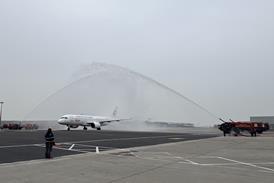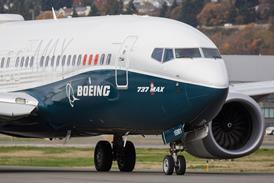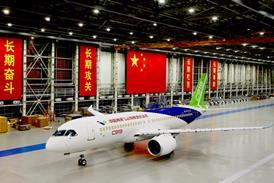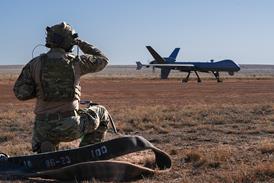Meanwhile aircraft makers, including regional manufacturers, have continued to cut costs and improve productivity in a depressed market. In February, the most recent examples of this saw both Boeing and Fokker announce further cuts.
Boeing's decision, driven in part by recent cancellations and deferrals from Air France, All Nippon Airways, Continental Airlines and USAir, will see some 7,000 jobs disappear this year - including 800 at the helicopter division - and a production cut on the B737 and B767 manufacturing lines. Monthly rates for the B737 will drop to seven per month in November from a current level of 8.5. B767 production will reach four units per month in April and then drop back to 3.5 per month in December. By year end employment levels will have dropped to 110,000 from almost 126,000 at the start of 1994.
The prospect of a net loss of $280 million for 1994 has led Dutch regional aircraft manufacturer Fokker to implement measures aimed at cutting costs to 50 per cent of 1992 levels and returning the company to profitability by 1996. Almost 21 per cent of the workforce faces redundancy as the company aims to cut labour levels by 1,760 to around 6,700 by mid-1996. Other measures include the closure of its headquarters in Amsterdam-Zuidoost and the Ypenburg factory and outsourcing of non-core activities. A separate profit centre, Fokker Aerostruc tures, will be set up to assume responsibility for components manufacturing, with design and assembly concentrated in a separate business unit - Fokker Aircraft. The company is also seeking a structural cut in the total wage bill of 10 per cent 'through adjustments in labour conditions.' Fokker had previously implemented production cutbacks from 85 to 50 aircraft a year.
The drop in cancellations last year produced 139 net orders for the big three manufacturers with 96 net orders for the four regional jet builders and 261 net orders for eight western turboprop manufacturers. The fight for market share among the big three took on added significance as Airbus gleefully proclaimed victory in 1994 with 125 firm and 71 net orders - the first time the European manufacturer has surpassed Boeing. But Boeing's 1994 net order figure of 65 aircraft could rise to 74 depending on which figures are used to calculate the B767 backlog. The Seattle-based giant did lose the firm order race with its European rival, only winning 120 of these in 1994. Had the Saudia order come in as expected, however, Boeing would have retained the top order spot.
Boeing argues, quite persuasively, that market share should be calculated on deliveries in the year as these are definite aircraft placements in a given period, while orders are open to cancellation and the delivery period is normally spread over a number of years. Based on deliveries, Boeing dominates with a market share of 62.5 per cent in 1994 against Airbus' 28.5 per cent and a worryingly low 9 per cent for McDonnell Douglas. Indeed, the future viability of the Long Beach-based manufacturer in the commercial aircraft market has to be in some doubt. MDC recorded three net orders in 1994 and has a comparatively small backlog of 167 aircraft. In fact, the assumptions of one recent forecast for orders and deliveries include the withdrawal of MDC from the commercial sector by 2000.
The turboprop delivery count reflects what Moody's analyst Tassos Philippakos terms as 'the regional market's three problems: overcapacity, overcapacity and overcapacity'. Eight manufacturers delivered only 208 aircraft in 1994.
Looking forward, most analysts predict an upturn in terms of deliveries in 1997. 'Production has been cut even more and that will hasten the arrival of tight supply. But as plans stand we conceive no upturn in deliveries until early 1997,' says Ed Greenslet at ESG Aviation Services.
John Vitale, Avitas' director asset valuation, believes the order cycle will start to turn up towards the end of this year. 'Now that airlines have put their internal houses in order, I like 1996 a lot better, especially for the jet market,' he says, adding that 1997 'will probably be a very good order year.'
Paul Ruddle, London-based analyst at SG Warburg, believes the trough in deliveries in the 100-seat and above market will come in 1996 at around 400 aircraft, as orders pick up. He supports the widely held belief that the next upturn will not culminate in a peak anywhere near as large as the 844 deliveries reached in 1991. The next peak, he says, will come between 2002 and 2004 topping out at some 480 deliveries.
Ruddle assumes a very modest growth in deliveries rising from the 1996 low to 410 in 1997, 435 in 1998, 450 in 1999 and dropping slightly to 445 in 2000. He believes that the move by manufacturers to cut down the lead times - both Airbus and Boeing have trimmed down the customer specification-to-delivery cycle to between 12 and 15 months and are aiming to cut that further - will result in a more conservative ordering policy from carriers. 'Airlines will not have to plan as far ahead on adding capacity,' he says. Increased availability of leased aircraft will also allow carriers more flexibility in fleet planning.
In the regional market, Vitale believes doubts over the future of manufacturers such as Jetstream and Embraer, overshadowed by merger talks and privatisation respectively, could have depressed orders in the turboprop market. But he believes the sector will recover over the next four years as replacement orders start to come in from the majors, particularly in the US. He also highlights an interesting battle developing between the new high-speed turboprops - the Saab 2000 and Dornier 328 - and the 'older' new technology turboprops. Airlines will have to choose between the high-speed turboprop's ability to expand hub catchment areas and offer more flexibility on scheduling and utilisation, and the commonality offered by ordering more of the 'older' generation aircraft like the Saab 340, he argues.
For Airbus, 1994 was certainly less frantic than 1993 when it rolled out its two wide-body aircraft, the A330 and A340. The only new project the European consortium is working on is the A319, a scaled-down version of the A320, for which construction of sections began last October. But the manufacturer is also looking at extended range options of the A340 and is considering downsizing the A330 to compete on range with the B767-ER with a greater payload capacity.
Study launched
Airbus says it is still involved with its four shareholders in studying a 600-800 seater aircraft with Boeing. Separately, the consortium also launched its own study for the 530-840 seat A3XX. Airbus has already given up on pulling a Japanese partner into the study but says that of those companies approached the Japanese were the only ones to 'show no real interest.'
January 1994 saw the first delivery of both the A321 to Lufthansa and the General Electric CF6-80 powered A330 to Air Inter. Despite a number of setbacks to the A330 programme last year, centred on the Pratt & Whitney-engined variant, the first PW4000-engined version was delivered, somewhat belatedly, to Thai Airways in December. Airbus is reported to be claiming some $70 million in compensation from Pratt & Whitney for the delay. The Rolls-Royce Trent 700-powered A330 went into service with Cathay Pacific in February.
Airbus refuses to discuss the impact of cost-cutting measures among its four shareholders in 1994 but claims an improved operating profit over 1993, despite a 2.3 per cent decline in revenues to $8.5 billion.
Boeing, with its more transparent accounting policy, reported a fall in both net profits and sales for 1994. The Seattle-based aircraft constructor reported a drop in revenues of 13.7 per cent over 1993 to $21.9 billion, with net profits down 31.2 per cent to $856 million.
The manufacturer is starting to wrap up its one major programme - the B777. Six aircraft are currently involved in flight testing, with the PW4084-powered version set for delivery to United Airlines in May. The GE90-powered version had its first flight in February while the debut flight of the Rolls-Royce Trent 800-powered version is set for May.
Boeing also launched the second model of its B737-X family, the B737-800, in November on the back of 16 orders from German charter carrier Hapag Lloyd. The manufacturer is still awaiting launch customers for the B737-600 derivative and the ultra-long range B777C. A stretch of the B777 is also under consideration.
Boeing is due to conclude its own market and technical studies for its 'super-jumbo', dubbed the VLCT, in mid-1995. The US manufacturer is also focusing on its joint 90-110 seater New Small Aircraft/YS-X study with Japan, but has indicated that it will not proceed with both the NSA and B737-600 programmes and will need to make a choice soon.
With a small positive net order book in 1994 of three aircraft, executives at McDonnell Douglas can expect another dearth of highlights this year besides the first delivery of the MD-90 to Delta Air Lines, scheduled for March. But the MD-90 programme was somewhat overshadowed by 12 cancellations during 1994 against only nine orders. The management is anxiously awaiting a launch order for the MD-95, which should come from a combination of SAS and possibly ILFC and Delta orders, if at all. SAS has put off its fleet renewal decision from last December and Fokker is bidding against the US manufacturer with the F100 and F70.
Concerns have also overshadowed the MD-11 programme but initial speculation that the line would be temporarily closed was quickly quashed by management. However, further problems surfaced with the discovery of cracks in the engine pylons of an American Airlines MD-11, which led to the FAA issuing an airworthiness directive to all MD-11 operators grounding any aircraft found with similar faults.
The merger of the marketing activities of British Aerospace's Jetstream and Avro regional aircraft subsidiaries with Franco-Italian consortium ATR was universally welcomed. The initial step, which sees the closure of the Jetstream 61 production line, will produce few synergies, other than the potential boost to sales by offering a complete portfolio of regional aircraft. The first real benefits will come in new aircraft development, with the high-speed ATR 82 as a possible first project.
Global market
'When you look at the industry there are 17 manufacturers in a global market that would ideally support three or four,' says Ruddle. The unanswered question is where do the other European manufacturers - Casa, Saab and Daimler Benz Aerospace, with its Fokker and Dornier subsidiaries - fit into the equation?
All three are still talking about joining a wider European consortium but any negotiations have been further complicated by the signing in March of a Memorandum of Understanding between Dasa and the Korean firm Samsung Aerospace to study the development of a 100-120 seater jet. Samsung signed the MoU as part of the Korean Commercial Aircraft Development Consortium and will pull Dasa into the joint regional jet study launched last year with China. Dasa's contribution will be led by Fokker, which is already considering an all-new 120-seater jet through its FAX programme.
With Asian partners on board, Dasa's hand can only be strengthened in any deal to join the BAe-ATR joint venture. This would put pressure on Avro to cede the lead role in the development of a future regional jet to Dasa, if the German conglomerate ever joined up with its European rivals.
Bombardier Regional Aircraft is still hoping to lauch its high-speed Dash 8-400, on which it has already incurred $50 million in development costs. Executive vice president Tom Appleton is hopeful the aircraft will be launched by the end of 1995. Deliveries of the Dash 8-200 are set to start in April.
Appleton is also aiming to launch the stretch of the Canadair Regional Jet, the CRJ-X, later this year and has already selected the CF34-2B1 power plant for the 70-seater jet.
If forecasts for the size of the jet market for 100-seaters and above prove correct, there is little doubt that all the manufacturers are going to continue to feel the squeeze. With complete families to offer, Airbus and Boeing are in the best position to prosper from any upturn in orders at the end of this year and into 1996. McDonnell Douglas will just have to hope that it can consolidate those niches in the market where it competes with the two main players.
In the regional manufacturing industry, consolidation still has far to go. But the lead given by the BAe-ATR linkup should help focus the minds of all those concerned. Overcap acity will not disappear overnight and without a large upturn in orders the market will not be able to sustain all the manufacturers. As developing countries continue to enter the regional fray, backed by governments in search of new technologies, the current players will need to ensure the outcome is joint ventures and not more competition.
In the regional manufacturing industry, consolidation still has far to go. But the lead given by the BAe-ATR linkup should help focus the minds of all those concerned. Overcap acity will not disappear overnight and without a large upturn in orders the market will not be able to sustain all the manufacturers. As developing countries continue to enter the regional fray, backed by governments in search of new technologies, the current players will need to ensure the outcome is joint ventures and not more competition.
Source: Airline Business


























